-

新人教版高中英语必修2Unit 1 Cultural Heritage-Reading and Thinking教案二
1. This section focuses on "Understanding how a problem was solved”, which is aimed to guide students to analyze and discuss the challenges and problems faced by cultural heritage protection during the construction of Aswan Dam, as well as the solutions. On the basis of understanding, students should pay attention to the key role of international cooperation in solving problems, and attach importance to the balance and coordination between cultural heritage protection and social and economic development. Students are encouraged to face challenges actively, be good at cooperation, and make continuous efforts to find reasonable ways and means to solve problems.2. Enable students to understand the main information and text structure of the reading text;3. Motivate students to use the reading strategy "make a timeline" according to the appropriate text genre;4. Enable students to understand how a problem was solved;5. Enable students to understand the value of protecting cultural heritage by teamwork and global community;1. Guide students to pay attention to reading strategies, such as prediction, self-questioning and scanning.2. Help students sort out the topic language about protecting cultural relics and understand the narrative characteristics of "time-event" in illustrative style3. Lead students to understand the value of protecting cultural heritage by teamwork and global community;

新人教版高中英语必修2Unit 3 The Internet-Discovering Useful Structure教案二
This teaching period mainly deals with grammar “The Present Perfect Passive Voice.” To begin with, teachers should lead students to revise what they have learned about the Present Perfect Passive Voice. And then, teachers move on to stress more special cases concerning this grammar。This period carries considerable significance to the cultivation of students’ writing competence and lays a solid foundation for the basic appreciation of language beauty. The teacher is expected to enable students to master this period thoroughly and consolidate the knowledge by doing some exercises. 1. Guide students to review the basic usages of the Present Perfect Passive Voice2. Lead students to learn to use some special cases concerning the Present Perfect Passive Voice flexibly.2. Enable students to use the basic phrases structures flexibly.3. Strengthen students’ great interest in grammar learning.1. Help students to appreciate the function of the Present Perfect Passive Voice in a sentence2. Instruct students to write essays using the proper the Present Perfect Passive Voice.观察下列句子特点,总结共同点。1.(教材P28)Much has been written about the wonders of the World Wide Web.2.(教材P28)But the Internet has done much more for people than simply make life more convenient.3.(教材P28)Many people have been helped by the club.4.(教材P28)She no longer feels lonely, and her company has become quite successful.5.(教材P32)Today I thought I’d blog about a question that has been asked many times—how do you stay safe online and avoid bad experiences on the Internet?

新人教版高中英语必修2Unit 4 History and Traditions-Discovering Useful Structure教案一
Step 5 Practice一、完成下列句子。1. Judy and I _______________(把车停下来(park))in an underground car Park near Trafalgar Square, where we could ______________________(让我们的车充电(charge)).2. When we finally reached the service desk to ask for audio guides, we heard it ___________ that there were no audio guides____________(留下,剩下).3. We__________________________(发现自己对...很惊讶)the large number of visitors and the amount of noise at the entrance of the National Gallery.4. Judy ____________________(眼神专注于) Van Gogh’s Sunflowers. It was hard to approach the painting as there were so many people around.5. She ____________________(把这幅画的复制品装箱(box)) to ensure that it was delivered safely.答案:1.had our car parked get our car battery charged 2. announced left 3. found ourselves very surprised 4. had her eyes fixed on 5. had a copy of the painting boxed二、用过去分词对下列句子进行改写。1. Loch Ness was surrounded by beautiful natural landscape, which made it look amazing.2. Carl and his friend stayed with a generous family who offered them bread with butter and honey that was homemade.3. The family’s ancestors once attended to soldiers who were wounded in the First World War.4. The young people were attracted by the legend of Loch Ness. They watched over the lake with their cameras and binoculars, which were positioned on the hill.答案:1. Loch Ness surrounded by beautiful natural landscape looks amazing.2. Carl and his friends stayed with a generous family who offered them homemade bread with butter and honey.3. The family’s ancestors once attended to wounded soldiers in the First World War.4. The young people attracted by the legend of Loch Ness watched over the lake with their cameras and binoculars positioned on the hill.

新人教版高中英语必修2Unit 4 History and Traditions-Discovering Useful Structure教案二
This teaching period mainly deals with grammar: The past participle is used as attributive and objective complement.1. Guide students to review the basic usages of the past participle used as attributive and objective complement.2. Lead students to learn to use some special cases concerning the past participle used as attributive and objective complement flexibly.3. Strengthen students’ great interest in grammar learning.1. Help students to appreciate the function of the past participle used as attributive and objective complement.2. Instruct students to write essays using the past participle used as attributive and objective complement.Step1:温故而知新。Analyze the underlined phrases and then sum up the common usages of the past participles.1.(教材P41)They had castles built(build) all around England, and made changes to the legal system.2.(教材P42)They use the same flag, known(know) as the Union Jack,...3.(教材P42)Judy and I had our car parked(park) in an underground car park near Trafalgar Square, where we could get our car battery charged(charge).Common points: f the past participle used as attributive and objective complement.Step 2:过去分词作定语时的意义1.及物动词的过去分词作定语,在语态上表示被动;在时间上,常表示动作已经发生或完成,有时也不表示时间性。Our teacher watched us doing the experiment and gave us a satisfied smile at last.我们的老师看着我们做实验,最后给了我们一个满意的微笑。The plan put forward at the meeting will be carried out soon.会上提出的计划将很快被执行。2.不及物动词的过去分词作定语,它不表示被动意义,只强调动作完成。Many little kids like gathering fallen leaves in the yard.

新人教版高中英语必修2Unit 4 History and traditions教案
这个地区有着深厚的传统。既学既练:为了让更多的外国游客了解中国文化,欣赏中国美丽的自然风光,感受中国发生的巨大变化,某外文杂志社将出版一本英语小册子来介绍中国的旅游景点。该杂志社邀请你为该小册子写一篇英语短文来介绍杭州,内容包括:1.杭州的位置(中国东南部)、面积(16 000多平方公里)及历史(2 200多年)等;2.杭州的旅游特色(自然风景、传统文化、特色小吃等);3.希望更多的游客来杭州参观。注意:1.词数80左右;2.可适当增加细节,以使行文连贯。Located in the southeast of China, Hangzhou is a beautiful city.Dating back more than 2,200 years, Hangzhou covers an area of more than 16,000 square kilometers.In Hangzhou, you can visit the West Lake, whose scenery is fascinating.In addition, you can’t miss its cultural relics and historical sites, from which you will learn more about excellent Chinese traditional culture and traditions.In Hangzhou, the special snacks are famous and visitors from different parts of the world think highly of them.As a tourist attraction, Hangzhou attracts a large number of visitors from home and abroad every year.Once you come to China, Hangzhou is a scenic spot you can’t miss.

新人教版高中英语必修2Unit 5 Music-Reading and Thinking教案二
1. Get basic information about Eric; read deeply to understand the history and development of the virtual choir.2. Understand what the function of the virtual choir is and how to make a virtual choir.3. Understand the meaning of some languages in the context of the text through question guidance, such as “Many people do not have close friends or contacts who have the same interest in music.” and so on.Step 1 Leading-in1. Answer the following questions.Q1:Do you know the Apps like Tik Tok and Quick Hand?Q2: Do you want to make a Tik Tok video or a Quick Hand video?2. Play a Tik Tok video Step 2: Understanding the title Q1:What does the title mean ?Q2: Is the article a narration or exposition? Why? Q3: Can you change the title ? If you can, what is the title?Step 3: Scanning the whole text and getting the basic information1. Answer the following questions.Q1:Who came up with the idea for a virtual choir?Q2: Where did Eric studied the musical composition?Q3: What is his song?2. Find the main idea of each paragraph3. Deal with some new words.Step 4: Reading carefully to get detailed informationPara 1 How to make a virtual choir1. PreparationA. tools: a virtual camera; an Internet connectionB. hero/heroin: friends or some individuals who have the same interests2. Process
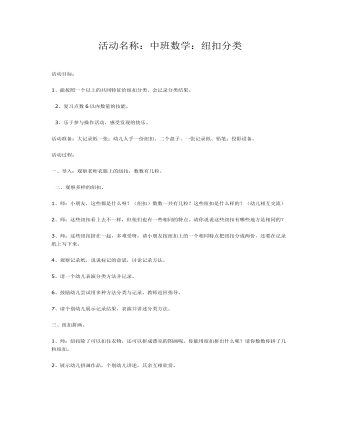
活动名称:中班数学:纽扣分类
2、复习点数6以内数量的技能。 3、乐于参与操作活动,感受发现的快乐。活动准备:大记录纸一张;幼儿人手一份纽扣、二个盘子、一张记录纸、铅笔;投影设备。活动过程:一、导入:观察老师衣服上的纽扣,数数有几粒。 二、观察多样的纽扣。1、师:小朋友,这些都是什么呀?(纽扣)数数一共有几粒?这些纽扣是什么样的?(幼儿相互交流)
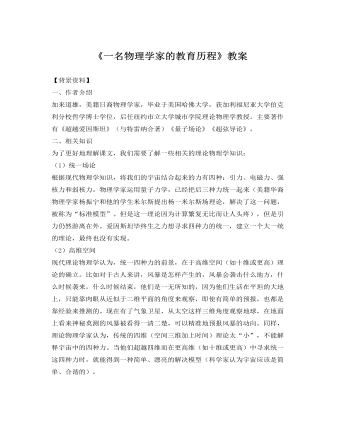
人教版高中语文《一名物理学家的教育历程》教案
一、导入新课成为一位科学家是无数有志青年的梦想,对物理的探究更是许多年轻的学子孜孜以求的,我们来看一下加来道雄的成长道路,或许能得到一些启发。(板书)一名物理学家的教育历程二、明确目标1.引导学生从生活出发,了解科学、认识科学2.引导学生以“教育历程”为重点,探讨其中表现的思想内涵。三、整体感知1.作者简介加来道雄,美籍日裔物理学家,毕业于美国哈佛大学,获加利福尼亚大学伯克利分校哲学博士学位,后任纽约市立大学城市学院理论物理学教授。主要著作有《超越爱因斯坦》(与特雷纳合著)《量子场论》《超弦导论》。2.本文的基本结构文章的题目是“一名物理学家的教育历程”,因此,叙述的顺序主要是历时性的。但是,作者开头就说“童年的两件趣事极大地丰富了我对世界的理解力,并且引导我走上成为一个理论物理学家的历程。”而“童年的两件趣事”作为文章的主要内容,又是共时性的叙述。这样的结构安排,使文章既脉络清楚,又重点突出。
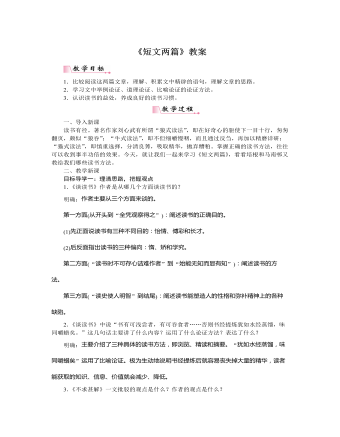
部编版语文九年级下册《短文两篇》教案
4.《不求甚解》一文分析了陶渊明怎样的读书态度,请指出“不求甚解”的两层含义。明确:态度:养成“好读书”的习惯;读书要诀在于“会意”。含义:第一,虚心,书不一定都能读懂;第二,读书方法:不固执一点,而要了解大意。5.《不求甚解》一文是驳论文还是立论文?又是如何驳或者立的?谈一谈你的理解。明确:驳论文。驳的是“论点”,先全面阐述“不求甚解”的含义,进而提倡虚心的“不求甚解”的读书态度,从而表明自己的观点;又从“会意”角度,列举古人读书的例子,并阐明自己的正确论点:读书在会意,不要死抠字眼,为一个局部而放弃整体;最后又强调了“书必须反复读”的主张。这样通过树立自己正确的观点从而驳倒敌论。
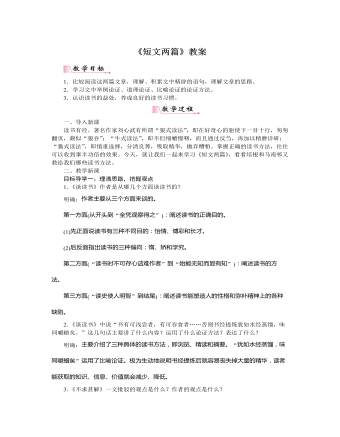
部编版语文九年级下册《短文两篇》教案
4.《不求甚解》一文分析了陶渊明怎样的读书态度,请指出“不求甚解”的两层含义。明确:态度:养成“好读书”的习惯;读书要诀在于“会意”。含义:第一,虚心,书不一定都能读懂;第二,读书方法:不固执一点,而要了解大意。5.《不求甚解》一文是驳论文还是立论文?又是如何驳或者立的?谈一谈你的理解。明确:驳论文。驳的是“论点”,先全面阐述“不求甚解”的含义,进而提倡虚心的“不求甚解”的读书态度,从而表明自己的观点;又从“会意”角度,列举古人读书的例子,并阐明自己的正确论点:读书在会意,不要死抠字眼,为一个局部而放弃整体;最后又强调了“书必须反复读”的主张。这样通过树立自己正确的观点从而驳倒敌论。
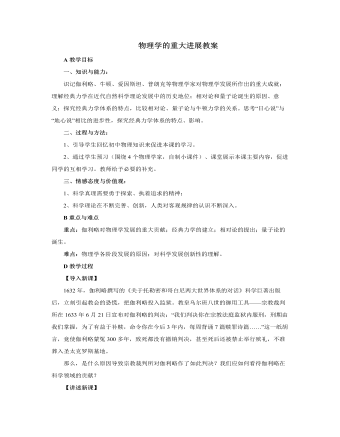
人教版高中历史必修3物理学的重大进展教案
B重点与难点重点:伽利略对物理学发展的重大贡献;经典力学的建立;相对论的提出;量子论的诞生。难点:物理学各阶段发展的原因;对科学发展创新性的理解。D教学过程【导入新课】1632年,伽利略撰写的《关于托勒密和哥白尼两大世界体系的对话》科学巨著出版后,立刻引起教会的恐慌,把伽利略投入监狱。教皇乌尔班八世的御用工具——宗教裁判所在1633年6月21日宣布对伽利略的判决:“我们判决你在宗教法庭监狱内服刑,刑期由我们掌握,为了有益于补赎,命令你在今后3年内,每周背诵7篇赎罪诗篇……”这一纸胡言,竟使伽利略蒙冤300多年,致死都没有撤销判决,甚至死后还被禁止举行殡礼,不准葬入圣太克罗斯墓地。那么,是什么原因导致宗教裁判所对伽利略作了如此判决?我们应如何看待伽利略在科学领域的贡献?

人教版高中历史必修3辉煌灿烂的文学教案
一、知识与能力:(1)了解中国古代不同时期的文学特色;(2)了解、诗,词、歌、赋等各种不同的知识内容和形式,知道和掌握一定数量的名家作品;(3)拓宽文化视野,提高赏析和运用古代文学作品的能力。二、过程与方法:(1)通过教科书及教师提供的材料以及自己的日常积累,通过阅读,讨论,分析,评论了解各个不同时期的文学发展特色。(2)通过阅读,观察,练习,欣赏,表演,评论,创作等方式积极参与教学;通过独立思考或合作学习对所学的内容进行比较,概括和阐释;学会合作学习和相互交流。三、情感态度与价值观:通过本课学习,了解中国古代灿烂的文化。通过对文学家、诗人及其文学作品的分析,把学生带进文学艺术的殿堂,感受古人的呼吸,思想,情操。增强文化修养。
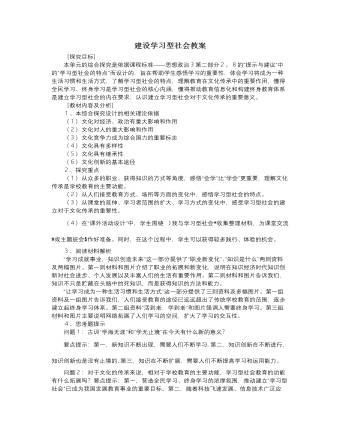
人教版高中政治必修3建设学习型社会教案
三、第三阶段。课后感悟与收获1、让学生以“走向学习型社会”为题,将在收集与整理、展示与交流两个环节中获得的体验和感悟,以心得体会的形式写一篇小论文。2、办一期专栏或黑板报,将优秀小论文作集中展示与交流。(进行理论总结,将实践与理论相结合,让科学理论更好地指导实践。充分挖掘学生潜力,增强学生的自信)[评析]新课程理念之一就是政治课不应只局限于课堂上的教与学。把综合探究课与研究性学习相结合,不失为一种有益的尝试。传统的学习方式把学习建立在客观性、受动性、依赖性的基础上,把学生看成一个没有感情的接受容器,这种学习会窒息学生的思维和智力,成为学生发展的障碍。单元探究活动的开展就是要转变学生的学习方式,关注学生的学习过程,使得探究过程成为学生发现问题、提出问题、分析问题、解决问题的过程,培养学生的创新精神和实践能力。本教案的第一阶段充分发挥了学生的主动性。
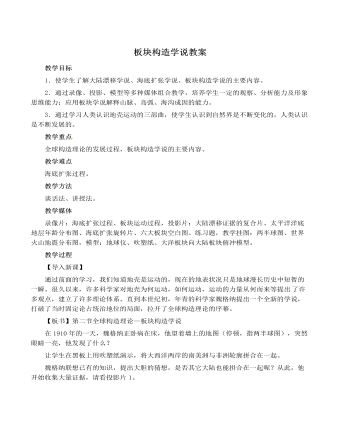
人教版高中地理选修1板块构造学说教案
【启发想象 】能否将刚才讲的内容用一个游泳动作形容一下?这好像蛙泳动作。我们大家一起做:熔岩冒出(双手合十向上)→推向两边(双手向两侧分开)→遇陆俯冲(双手往下)→重熔再生(双手相向合并向上)。【小结板书】二、海底扩张学说前面我们学习了两个假说,整理一下已知条件:事实证明大陆是在漂移的,如欧洲与美洲的距离在扩张,但是漂移的动力不足;海底是不断扩张的,有生长与消亡。能否在前人研究的基础上,提出更准确更合理的假设呢?一个新的理论诞生了,它是目前最盛行、最活跃的全球构造理论【板书】三、板块构造学说1.板块概念学生读书。【启发提问】板块“漂移”与大陆“漂移”的位置有何不同?学生回答。板块漂移是指岩石圈漂在软流层上,大陆漂移发生在地壳两层之间。【提问】板块是如何划分的?读图用半分钟记下六大板块的位置和名称(提示:按大洲和大洋名称记忆)。
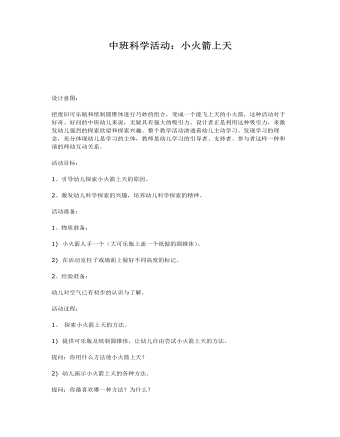
中班科学活动 《小火箭上天》课件教案
活动目标:1、引导幼儿探索小火箭上天的原因。2、激发幼儿科学探索的兴趣,培养幼儿科学探索的精神。活动准备:1、物质准备:1) 小火箭人手一个(大可乐瓶上盖一个纸做的圆锥体)。2) 在活动室柱子或墙面上做好不同高度的标记。
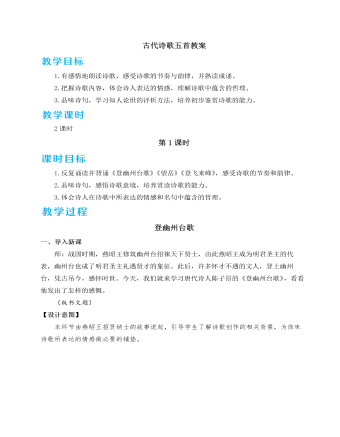
人教部编版七年级下册古代诗歌五首教案
师小结:《己亥杂诗》(其五)抒发了诗人离京南返的无尽愁绪,也表达出诗人虽已辞官,仍决心为国效力、奉献终生的决心,以及对国家民族的那份执着挚爱之情。全诗寄情于物,形象贴切,浑然一体,感人至深。【设计意图】本环节运用知人论世的方法,巧妙地将诗歌和写作背景糅合在一起,让学生逐步深入地理解诗人的情感和志趣。五、总结存储1.教师总结。本课学习了两首诗,让我们又获得了新的教益。《游山西村》中的名句“山重水复疑无路,柳暗花明又一村”让我们明白了在困境中坚持下去,也许会出现令人豁然开朗的转变,世间事物是消长变化的。《己亥杂诗》(其五)中的名句“落红不是无情物,化作春泥更护花”让我们感受到作者的爱国忧民、无私奉献精神。希望同学们能热爱传统文化,热爱古代的诗歌艺术,让这些经典文化伴你们健康成长。2.布置作业。(1)背诵并用楷书工整、规范地默写这两首诗。(2)选择感受最深的一首,发挥想象,写成一篇文章。(500字左右)。
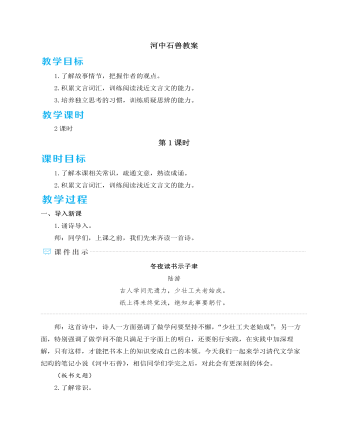
人教部编版七年级下册河中石兽教案
4.充当状语的名词和中心词之间要连读,即名词作状语时,一般在该词前停顿,且不能把状语与中心词读开。若分开读,就错将状语当成了主语,改变了句子的意思。5.“而”字后应该停顿。但“而”字在句中若起到下列作用,那么就不能停顿,也就是说,“而”字不能和后面的词语分开读,应该连读。(1)“而”在句中如果连接的是形容词(或副词)与动词,即“形容词(副词)+而+动词”,这时前边的形容词或副词充当状语,起修饰后面的动词的作用,不能分开读。(2)“而”在句中如果连接的是两个动词,即“动词+而+动词”,那么“而”表示顺承,也就是说,前面一个动作发生了,后面的动作紧接着就发生了,这时“而”后面就不能停顿,应和后面的动词连读。(3)“而”连接词性相同的两个词语(即两个名词、两个动词、两个形容词),表示并列,可译为“而且”“又”“和”或不译,这时“而”后不应该停顿。(4)“而”表示递进关系,可译为“而且”“并且”“就”或不译,这时“而”后不能停顿。
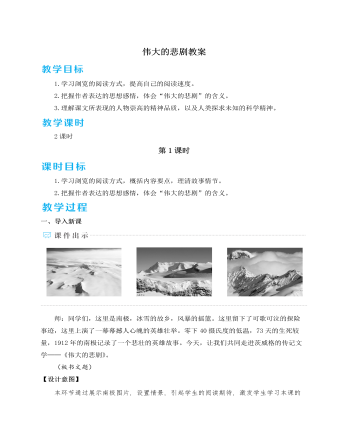
人教部编版七年级下册伟大的悲剧教案
预设 示例:(1)斯科特,寒冷的冰雪虽然冻住了你的身体,但它却冻不住你那高尚无比的灵魂。(2)威尔逊博士,凶猛的暴风雪只是带走了你的身躯,却没有带走你那热爱科学、无私奉献的精神和对祖国的那份深沉的爱。2.以史明鉴,畅写启示。(1)畅写启示。师:作者在课文结尾满怀深情地写道:“一个人虽然在同不可战胜的厄运的搏斗中毁灭了自己,但他的心灵却因此变得无比高尚。所有这些在一切时代都是最伟大的悲剧。”联系实际,说说你所知道的“伟大的悲剧式”的人物或事件,这些人物或事件对你有什么启示?把自己的想法写出来。(2)引导交流。“伟大的悲剧式”的人物或事件及其启示:示例一:美国的航天飞机“挑战者号”在升空约72秒后突然爆炸,机上7名宇航员全部罹难。
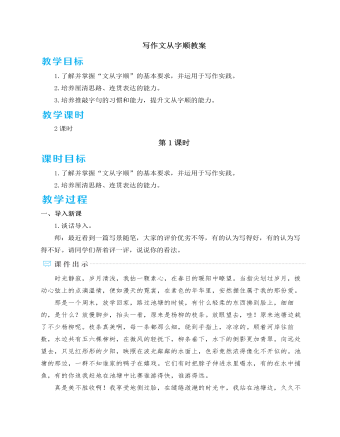
人教部编版七年级下册写作文从字顺教案
二、升格训练师:大文豪曹雪芹写《红楼梦》是“披阅十载,增删五次”,可见修改是写作获得成功的必然环节,很多文学名家对此也深有感触。这些古今中外的作家,都向我们推荐了一种修改文章的好方法——朗读修改法。结合你自己的写作经验,你觉得大声朗读可以发现习作中的哪些问题?预设 如有些词语听起来不顺耳,有些句子读起来不顺口,有些段落缺少过渡,或前后意思重复,有些地方表达不清楚,有些修辞手法的运用欠妥,有些标点的运用不规范等,这些问题都能够在朗读中发现。2.再改随笔。师:之前修改写景随笔,用的是默读修改法,这次换作朗读修改法,会不会有新的收获呢?请大家朗读病文,然后小组讨论:文中还有哪些用词不恰当、语句不连贯的地方,找出来并进行修改,使之文从字顺。(生朗读随笔,修改后交流讨论并展示)预设 (1)“有什么轻柔的东西拂到脸上,细细的”,可以把“轻柔的”改成叠词“柔柔的”,放到后面,和“细细的”并列,这样读起来音律感要好些。
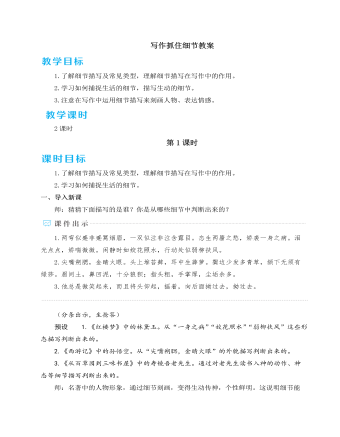
人教部编版七年级下册写作抓住细节教案
(生动手写下来,小组交流,推荐三至五个同学全班交流)师小结:正如巴尔扎克说的“唯有细节将组成作品的价值”。同学们在写作中可恰当地添加肖像、语言、动作、景物等细节描写,用上合适的修辞手法,细化分解过程,尽最大的努力,让描写细致生动起来,让内容充实起来。【设计意图】本环节引导学生通过具体句子的分析对比,学习归纳表达细节的方法,并运用这些方法练习。这些方法可操作性强,易于学生学习和评价。三、实践运用,描摹细节1.修改习作,打磨细节。(1)在本节课开头展示的修改习作中选出两篇。(生推荐,屏幕展示)(2)师生就所选习作中的某个段落,围绕一个中心词,如喜欢、赞赏、讨厌、厌恶等,全班集体修改,学习如何运用肖像、语言和动作等细节描写表情达意。(3)展示修改片段,对比原文。(4)生点评修改效果谈收获。






